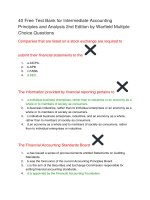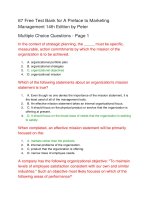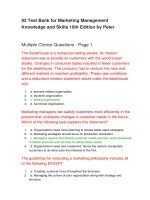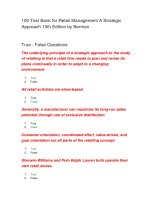Test bank for horngrens accounting the managerial chapters 10th edition by nobles
Bạn đang xem bản rút gọn của tài liệu. Xem và tải ngay bản đầy đủ của tài liệu tại đây (232.04 KB, 38 trang )
Test Bank for Horngrens Accounting The Managerial Chapters
10th Edition by Nobles
The income statement of a service company will most likely include:
1. A) salary expense.
2. B) factory overhead.
3. C) cost of goods sold.
4. D) direct materials.
Which of the following is true of service companies?
1. A) All of service companies' costs are product costs.
2. B) Service companies modify and resell products they buy from
manufacturers.
3. C) Revenues of service companies are only recorded on cash receipt.
4. D) Service companies carry no inventories of products for sale.
For a manufacturing company, which of the following is a period cost?
1. A) Direct materials
2. B) Office rent
3. C) Wages expense of factory workers
4. D) Indirect materials
One of the primary activities of Rex Inc. is to purchase hats from Viva Inc. in
Texas and sell them to its customers in Washington for a profit. It is likely that
Rex is a:
1. A) manufacturing company.
2. B) hybrid company.
3. C) service company.
4. D) merchandising company.
Which of the following is most likely a service company?
1. A) a law firm
2. B) a car manufacturer
3. C) a fruit seller
4. D) a baker
A company that uses labor, equipment, supplies, and facilities to convert raw
materials into finished products is a:
1. A) merchandising company.
2. B) manufacturing company.
3. C) service company.
4. D) trading company.
Goods that have been started in the manufacturing process but are not yet
complete are included in:
1. A) the Finished Goods Inventory account.
2. B) the Work-in-Process Inventory account.
3. C) the Raw Materials Inventory account.
4. D) the Cost of Goods Sold account.
Which of the following would appear as a line item on the income statements
of both, a merchandiser and a manufacturer?
1. A) Direct Labor
2. B) Cost of Goods Manufactured
3. C) Direct Materials
4. D) Cost of Goods Sold
Damsel Inc. is a large manufacturer of auto tires. Damsel has provided the
following information: Sales Revenue $45,500 Beginning Finished Goods
Inventory 1,500 Cost of Goods Sold 32,500 Cost of Goods Manufactured
35,000 Calculate the amount of ending finished goods inventory reported in
Damsel's balance sheet.
1. A) $10,500
2. B) $36,500
3. C) $4,000
4. D) $3,500
The balance sheet of a ________ company will show Work-in-Process Inventory
as a line item.
1. A) manufacturing
2. B) merchandising
3. C) service
4. D) trading
Partial income statements of Company A and Company B are provided below:
Which of the following statements is true?
1. A) Company A is a merchandising company.
2. B) Company B is a manufacturing company.
3. C) Company A is a manufacturing company.
4. D) Company A is a service company.
Product costs are expensed:
1. A) when the products are consumed or sold.
2. B) at the end of the accounting period they are incurred in.
3. C) when the products are transferred to Work-in-Process Inventory account.
4. D) when the market value of products goes above the recorded value.
The Work-in-Process Inventory account includes the:
1. A) goods that are ready to be sold.
2. B) goods that are partially completed.
3. C) goods that have been sold in the market.
4. D) goods that are damaged during production.
Which of the following is true of finished goods inventory?
1. A) Finished Goods Inventory is an account used by a manufacturer and
includes completed goods that have not yet been sold.
2. B) Finished Goods Inventory is an account used by a merchandiser and
includes completed goods that have not yet been sold.
3. C) Finished Goods Inventory is an account used by service companies in lieu
of raw materials inventory.
4. D) Finished Goods Inventory is an account used by a manufacturer in lieu of
raw materials inventory.
Which of the following is true of product costs?
1. A) They are expensed in the period they are paid.
2. B) For external reporting, GAAP requires that they be expensed before the
products are sold.
3. C) They are first recorded in an inventory account.
4. D) For merchandising companies, product costs do not include freight costs.
Crystal Inc. is a merchandiser of stone ornaments. It sold 15,000 units in
2015. The company has provided the following information: Sales Revenue
$557,000 Purchases (excluding freight in) 300,000 Selling and Administrative
Expenses 69,000 Freight In 15,000 Beginning Merchandise Inventory 45,000
Ending Merchandise Inventory 55,700 How much is the gross profit for
2015?
1. A) $183,700
2. B) $304,300
3. C) $252,700
4. D) $257,000
Which of the following formulas represents cost of goods sold for a
merchandising business?
1. A) Beginning Inventory - Ending Inventory = Cost of Goods Sold
2. B) Purchases and Freight In - Ending Inventory = Cost of Goods Sold
3. C) Ending Inventory + Purchases and Freight In - Beginning Inventory = Cost
of Goods Sold
4. D) Beginning Inventory + Purchases and Freight In - Ending Inventory = Cost
of Goods Sold
Product costs, such as factory overhead, should be treated as an asset until
the product is sold.
1. True
2. False
Manufacturing overhead includes all manufacturing costs, such as direct labor
and direct materials.
1. True
2. False
Manufacturing overhead includes indirect manufacturing costs, such as
insurance and depreciation on the factory building.
1. True
2. False
All costs incurred in the manufacture of final products are product costs.
1. True
2. False
The cost of direct materials cannot easily be traced to the manufactured
product, and therefore it is a component of manufacturing overhead.
1. True
2. False
Wages and benefits of assembly line workers are period costs.
1. True
2. False
Wages and benefits of assembly line workers are included in manufacturing
overhead.
1. True
2. False
Wages and benefits of factory managers are considered as product costs.
1. True
2. False
The three categories of period costs are direct materials, direct labor, and
manufacturing overhead.
1. True
2. False
Salary of a factory manager will be included in manufacturing overhead.
1. True
2. False
Direct costs and indirect costs can be easily traced directly to a cost
object.
1. True
2. False
In a manufacturing firm, the salary of sales staff is an example of period
cost.
1. True
2. False
Wages of factory janitors is considered non-manufacturing overhead, as these
are not directly related to the manufacturing process.
1. True
2. False
Indirect materials costs such as lubes and cleaning fluids are product
costs.
1. True
2. False
Indirect materials costs are included in manufacturing overhead.
1. True
2. False
For a manufacturer, rent paid for an office building is an example of a period
cost.
1. True
2. False
Factory rent, taxes, and insurance are included in manufacturing
overhead.
1. True
2. False
Transportation costs paid to ship raw materials to a company warehouse are
considered product costs.
1. True
2. False
Sales commissions are included in manufacturing overhead.
1. True
2. False
In a manufacturing firm, advertising and marketing costs are examples of
period costs.
1. True
2. False
In a manufacturing firm, advertising and marketing costs are included in
manufacturing overhead.
1. True
2. False
In a manufacturing firm, accounting, legal, and administrative costs are
typical examples of product costs.
1. True
2. False
In a manufacturing firm, administrative costs are included in period
costs.
1. True
2. False
Repair and maintenance costs for factory equipment are product costs.
1. True
2. False
Repair and maintenance costs for factory equipment are included in
manufacturing overhead.
1. True
2. False
Repair and maintenance costs of vehicles used to deliver products to
customers are product costs.
1. True
2. False
Repair and maintenance costs of vehicles used to deliver products to the
customers are included in manufacturing overhead.
1. True
2. False
Direct materials and direct labor are prime costs.
1. True
2. False
In manufacturing, the cost objects are often units of product.
1. True
2. False
Period costs are the:
1. A) current assets and liabilities reported on the balance sheet.
2. B) costs that are incurred and expensed during the same accounting period.
3. C) costs related to production of products the company purchases and sells.
4. D) same as manufacturing overhead costs.
Jasper Inc. reports the following cost information for March: Cost of Goods
Manufactured $75,000 Manufacturing Overhead 18,250 Finished Goods
Inventory, March 1 4,500 Finished Goods Inventory, March 31 2,650 Work-inProcess Inventory, March 1 9,670 Work-in-Process Inventory, March 31 1,250
Direct Materials Used 25,300 What is the cost of goods sold for March?
1. A) $83,420
2. B) $73,150
3. C) $76,850
4. D) $82,150
Jasper Inc. reports the following cost information for March: Cost of Goods
Manufactured $75,000 Manufacturing Overhead 18,250 Finished Goods
Inventory, March 1 4,500 Finished Goods Inventory, March 31 2,650 Work-inProcess Inventory, March 1 9,670 Work-in-Process Inventory, March 31 1,250
Direct Materials Used 25,300 What is the amount of direct labor incurred by
Jasper in March?
1. A) $29,600
2. B) $39,870
3. C) $126,970
4. D) $23,030
Jasper Corporation reports the following cost information for March: Cost of
Goods Manufactured $75,000 Manufacturing Overhead 18,250 Finished Goods
Inventory, March 1 4,500 Finished Goods Inventory, March 31 2,650 Work-inProcess Inventory, March 1 9,670 Work-in-Process Inventory, March 31 1,250
Direct Labor 36,300 What is the amount of direct materials used by Jasper in
March?
1. A) $12,030
2. B) $18,600
3. C) $28,870
4. D) $137,970
Jasper Corporation reports the following cost information for March: Cost of
Goods Manufactured $75,000 Direct Materials Used 16,850 Finished Goods
Inventory, March 1 4,500 Finished Goods Inventory, March 31 2,650 Work-inProcess Inventory, March 1 9,670 Work-in-Process Inventory, March 31 1,250
Direct Labor 36,300 What is the amount of manufacturing overhead incurred
by Jasper in March?
1. A) $20,000
2. B) $30,270
3. C) $13,430
4. D) $136,570
A company used $35,000 of direct materials, incurred $73,000 in direct labor
cost, and $114,000 in manufacturing overhead costs during the period. If
beginning and ending Work-in-Process Inventories were $28,000 and $21,000
respectively, what is the cost of goods manufactured?
1. A) $250,000
2. B) $229,000
3. C) $215,000
4. D) $222,000
Given the following information, determine the cost of goods manufactured.
Direct Labor Incurred $63,000 Manufacturing Overhead Incurred 179,500
Direct Materials Used 150,000 Finished Goods Inventory, 1/1/2015 197,500
Finished Goods Inventory, 12/31/2015 221,000 Work-in-Process Inventory,
1/1/2015 96,500 Work-in-Process Inventory, 12/31/2015 109,000
1. A) $243,000
2. B) $380,000
3. C) $867,000
4. D) $160,000
Given the following information, determine the cost of goods sold. Direct
Labor Incurred $63,000 Manufacturing Overhead Incurred 179,500 Direct
Materials Used 150,000 Finished Goods Inventory, 1/1/2015 197,500 Finished
Goods Inventory, 12/31/2015 221,000 Work-in-Process Inventory, 1/1/2015
96,500 Work-in-Process Inventory, 12/31/2015 109,000
1. A) $380,000
2. B) $1,016,500
3. C) $356,500
4. D) $414,000
The cost of goods sold for Frye Manufacturing in 2015 was $233,000. The
January 1, 2015, finished goods inventory balance was $31,600, and the
December 31, 2015, finished goods inventory balance was $24,200. Calculate
the cost of goods manufactured during 2015.
1. A) $288,800
2. B) $233,000
3. C) $225,600
4. D) $240,400
Which of the following will most likely be considered an indirect material cost
for a bakery?
1. A) Spices
2. B) Flour
3. C) Milk
4. D) Eggs
The following information has been provided by Squash Corporation: Direct
Labor $6,500 Direct Materials Used 2,550 Raw Materials Purchased 5,000 Cost
of Goods Manufactured 10,500 Ending Work-in-Process Inventory 1,200
Corporate Headquarters' Property taxes 350 Manufacturing Overhead 510 The
beginning balance of Work-in-Process Inventory account was:
1. A) $2,400.
2. B) $2,140.
3. C) $18,860.
4. D) $9,560.
Barricades Corporation provided the following information for the year 2015:
Beginning Balance—Work-in-Process Inventory $24,000 Ending Balance—
Work-in-Process Inventory 56,000 Beginning Balance—Raw Materials
Inventory 84,000 Ending Balance—Raw Materials Inventory 60,000 Purchases
—Raw Materials 360,000 Direct Labor 470,000 Indirect Materials 47,000
Indirect Labor 19,000 Depreciation on Factory Plant & Equipment 24,000 Plant
Utilities & Insurance 270,000 What was the amount of direct materials used in
production during 2015?
1. A) $360,000
2. B) $504,000
3. C) $384,000
4. D) $328,000
Barricades Corporation provided the following information for the year 2015:
Beginning Balance—Work-in-Process Inventory $24,000 Ending Balance—
Work-in-Process Inventory 56,000 Beginning Balance—Raw Materials
Inventory 84,000 Ending Balance—Raw Materials Inventory 60,000 Purchases
—Raw Materials 360,000 Direct Labor 470,000 Indirect Materials 47,000
Indirect Labor 19,000 Depreciation on Factory Plant & Equipment 24,000 Plant
Utilities & Insurance 270,000 What was the amount of manufacturing
overhead costs?
1. A) $360,000
2. B) $313,000
3. C) $90,000
4. D) $336,000
Barricades Corporation provided the following information for the year 2015:
Beginning Balance—Work-in-Process Inventory $24,000 Ending Balance—
Work-in-Process Inventory 56,000 Beginning Balance—Raw Materials
Inventory 84,000 Ending Balance—Raw Materials Inventory 60,000 Purchases
—Raw Materials 360,000 Direct Labor 470,000 Indirect Materials 47,000
Indirect Labor 19,000 Depreciation on Factory Plant & Equipment 24,000 Plant
Utilities & Insurance 270,000 What was the total manufacturing cost incurred
during the year 2015?
1. A) $744,000
2. B) $360,000
3. C) $1,414,000
4. D) $1,214,000
Barricades Corporation provided the following information for the year 2015:
Beginning Balance—Work-in-Process Inventory $24,000 Ending Balance—
Work-in-Process Inventory 56,000 Beginning Balance—Raw Materials
Inventory 84,000 Ending Balance—Raw Materials Inventory 60,000 Purchases
—Raw Materials 360,000 Direct Labor 470,000 Indirect Materials 47,000
Indirect Labor 19,000 Depreciation on Factory Plant & Equipment 24,000 Plant
Utilities & Insurance 270,00 What was the amount of the cost of goods
manufactured for the year 2015?
1. A) $1,414,000
2. B) $1,214,000
3. C) $1,182,000
4. D) $1,246,000
Viva Inc. has provided the following information for the year 2015: Cost of
Goods Manufactured $1,234,000 Beginning Balance—Finished Goods
Inventory 99,000 Ending Balance—Finished Goods Inventory 84,000 How
much is the cost of goods sold?
1. A) $183,000
2. B) $1,249,000
3. C) $1,234,000
4. D) $1,219,000
Amoeba Manufacturing Company provided the following information for the
year 2015: Purchases—Raw Materials $90,000 Plant Utilities & Insurance
67,500 Indirect Materials 11,750 Indirect Labor 4,750 Direct Materials Used in
Production 96,000 Direct Labor 117,500 Depreciation on Factory Plant &
Equipment 6,000 The inventory account balances as of January 1st 2015 are
given below. Raw Materials Inventory $42,000 Work-in-Process Inventory
12,000 Finished Goods Inventory 49,500 What is the ending balance in the
Raw Materials Inventory account?
1. A) $54,000
2. B) $6,000
3. C) $111,000
4. D) $24,250
Amoeba Manufacturing Company provided the following information for the
year 2015: Purchases—Raw Materials $90,000 Plant Utilities & Insurance
67,500 Indirect Materials 11,750 Indirect Labor 4,750 Direct Materials Used in
Production 96,000 Direct Labor 117,500 Depreciation on Factory Plant &
Equipment 6,000 Cost of Goods Manufactured 290,850 The inventory account
balances as of January 1st 2015 are given below. Raw Materials Inventory
$42,000 Work-in-Process Inventory 12,000 Finished Goods Inventory 49,500
What is the ending balance in the Work-in-Process Inventory account?
1. A) $24,650
2. B) $12,000
3. C) $49,500
4. D) $65,350
Amoeba Manufacturing Company provided the following information for the
year 2015: Purchases—Raw Materials $90,000 Plant Utilities & Insurance
67,500 Indirect Materials 11,750 Indirect Labor 4,750 Direct Materials Used in
Production 96,000 Direct Labor 117,500 Depreciation on Factory Plant &
Equipment 6,000 Cost of Goods Manufactured 290,850 Cost of Goods Sold
304,550 The inventory account balances as of January 1st 2015 are given
below. Raw Materials Inventory $42,000 Work-in-Process Inventory 12,000
Finished Goods Inventory 49,500 What is the ending balance in the finished
goods inventory?
1. A) $49,500
2. B) $63,200
3. C) $35,800
4. D) $24,650
The following information has been provided by Nugget Company: Direct
Labor $25,000 Direct Materials Used 10,000 Raw Materials Purchased 16,750
Cost of Goods Manufactured 49,750 Ending Work-in-Process Inventory 11,500
Corporate Headquarters' Property Taxes 1,500 Manufacturing Overhead
19,750 Calculate the beginning balance of the Work-in-Process Inventory
account.
1. A) $5,000
2. B) $10,500
3. C) $6,500
4. D) $16,500
Reed Production has provided the following information for the year 2015:
Direct Labor $153,000 Beginning Work-in-Process Inventory 62,500 Direct
Materials Used 271,000 Ending Work-in-Process Inventory 53,850
Manufacturing Overhead 135,500 During the year, Reed produced 71,020
units of product. Calculate the unit product cost.
1. A) $8.00
2. B) $10.00
3. C) $9.52
4. D) $7.88
Evanston Manufacturing Company reported the following information for the
year 2015: Number of Units Produced 4,800 Number of Units Sold 5,250 Cost
of Goods Manufactured $460,800 Cost of Goods Sold $488,250 Sales Revenue
$1,260,000 Gross Profit $771,750 Operating Expense $724,900 What was the
unit product cost?
1. A) $87.77
2. B) $262.50
3. C) $93.00
4. D) $96.00
South State Company used $71,000 of direct materials and incurred $37,000
of direct labor costs during 2015. Indirect labor amounted to $2,700 while
indirect materials used totaled $1,600. Other operating costs pertaining to
the factory included utilities of $3,100; maintenance of $4,500; repairs of
$1,800; depreciation of $7,900; and property taxes of $2,600. There was no
beginning or ending finished goods inventory, but Work-in-Process inventory
began the year with a $5,500 balance and ended the year with a $7,500
balance. How much is the cost of goods manufactured?
1. A) $124,700
2. B) $130,200
3. C) $137,700
4. D) $132,200
Arturo Manufacturing Company provided the following information for the
year 2015: Beginning Balance—Work-in-Process Inventory $12,000 Ending
Balance—Work-in-Process Inventory 28,000 Beginning Balance—Raw Materials
Inventory 42,000 Ending Balance—Raw Materials Inventory 30,000 Purchases
—Raw Materials 180,000 Direct Labor 235,000 Indirect Materials 23,500
Indirect Labor 9,500 Depreciation on Factory Plant & Equipment 12,000 Plant
Utilities & Insurance 135,000 How much is the cost of goods
manufactured?
1. A) $591,000
2. B) $607,000
3. C) $619,000
4. D) $579,000
Managerial accounting is used in manufacturing and merchandising
companies, but not in service companies.
1. True
2. False
Service companies do not have product costs so they often consider all
operating expenses as part of their cost of service.
1. True
2. False
Managerial accounting can be used to calculate costs for service and
merchandising companies.
1. True
2. False
A merchandiser need not calculate cost per unit as it resells goods that are
already manufactured.
1. True
2. False
Cost per service is calculated by dividing total costs by total number of
services provided.
1. True
2. False
Nurix Inc. is a business consulting firm. During the month of February, Nurix
earned $55,400 of revenues by providing services to 45 clients. Operating
expenses for February were $8,500 and non-operating expenses were $4,500.
What is the cost per service?
1. A) $100.00
2. B) $188.88
3. C) $942.22
4. D) $288.00
Samson Inc. reported the following information for the year 2015: Service
Revenue $40,000 Operating Expenses $23,625 Net Income $16,375 Number of
Services Provided for the Year 10,500 How much was the unit cost per
service?
1. A) $1.56
2. B) $3.20
3. C) $2.25
4. D) $3.81
Crystal Inc. is a merchandiser of stone ornaments. The company sold 15,000
units in 2015. The company has provided the following information: Sales
Revenue $557,000 Purchases (excluding freight in) 300,000 Selling and
Administrative Expenses 69,000 Freight In 15,000 Beginning Merchandise
Inventory 45,000 Ending Merchandise Inventory 55,700 What is the cost per
unit sold?
1. A) $20.29
2. B) $15.00
3. C) $23.88
4. D) $12.25
Five Seasons is a merchandiser of packed foods. The company provides the
following information for the year 2015: Sales Revenue $140,000 Cost of
Goods Sold $63,000 Operating Expenses $67,500 Net Income $9,500 Number
of Units Sold 27,000 How much was the unit cost per unit of product
sold?
1. A) $3.14
2. B) $5.18
3. C) $2.33
4. D) $0.82
Fuchsia Inc. provides automobile services in the local community. The
company provides the following information for the month of March: Building
Rent Expense $5,000 Depreciation Expense—Equipment 1,700 Supplies
Expense 8,500 Utilities Expense 2,450 Fuchsia provided services to 1,500
clients in the month of March and generated $20,500 as revenue. How much
is the cost per service?
1. A) $11.77
2. B) $5.18
3. C) $13.67
4. D) $10.63
Star Health Inc. is a fitness center in Oklahoma City. In October, the company
earned $550,000 in revenues and incurred the following operating costs from
340 customers: Manager's salary $50,000 Gym Rent 60,000 Depreciation
Expense—Equipment 25,000 Office Supplies 30,000 Utilities Expense 89,700
Trainer's Salary 25,000 How much is the unit cost per customer service?
1. A) $795.00
2. B) $749.12
3. C) $1,617.65
4. D) $822.65
Kentucky purchases and sells widgets. The following information summarizes
Kentucky's operating activities for 2015: Selling and Administrative Expenses
$4,500 Purchases 157,000 Sales Revenue 785,000 Merchandise Inventory,
January 1, 2015 38,250 Merchandise Inventory, December 31, 2015 79,000 If
Kentucky sold 7,500 units of widgets during 2015, how much is the cost for
one widget?
1. A) $50.00









